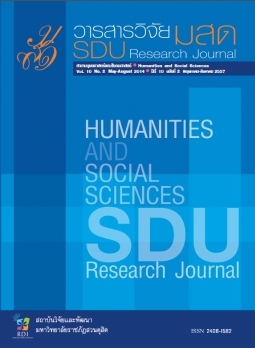University initiation and the formation of group cohesion among students: A mediating role of social identification
Keywords:
Hazing, University Initiation, Social Identification, Group CohesionAbstract
This research examined the relationship between universities’ initiations (both constructive and destructive forms), and group cohesion among Thai university students with social identification as a mediator. Participants were undergraduate students who had experienced initiation from various universities in the Bangkok Metropolitan Area (N = 200). The results of Multiple Regression Analysis using PROCESS (Hayes, 2013) revealed that constructive-initiation-activity (CIA) had a significant positive direct effect on students’ group cohesion at p < .05. In contrast, destructive-initiation-activity (DIA) found no significant direct effect on neither social identification nor group cohesion. In addition, we found that social
identification was a significant partial mediator for the relationship between CIA and group cohesion. These findings indicated that relevant departments, as well
as senior students, should be encouraged to promote CIA within university faculty, in order to help newcomers identify themselves with the faculty. This can
subsequently lead to formation of group cohesion among students.
References
Choochom et al. (1999). Effect of initiation activity and
cheering meeting (Research Report), Bangkok Srinakharinwirot University. Dias, D., & Sá, M. J. (2012). Initiation rituals in university
as lever for group cohesion. Journal of Further and Higher Education, 38(4), 447-464. Evans, C. R., & Dion, K. L. (2012). Group Cohesion and
Performance: A Meta-Analysis. Small Group Research, 43(6), 690-701. Forrester, W. R., & Tashchian, A. (2006). Modeling the
Relationship between Cohesion and Performance in Student Work Groups. International Journal of
Management, 23(3), 458-464. Forsyth, D. R. (2013). Group dynamics. Belmont, CA:
Wadsworth Cengage Learning. Hayes, A. F. (2013). Introduction to Mediation, Moderation, and Conditional Process Analysis: A Regression-Based Approach. New York, NY: The Guilford Press. Journal of Educational Measurement, 51(3), 335-337. Hoover, N. C. (1999). National survey: Initiation rites and athletics for NCAA sports teams. Alfred, NY: Alfred University. Johnson, J., & Chin, J. W. (2015). Hazing rites/rights: Using outdoor- and adventure education-based orientation to effect positive change for first-year athletes. Journal of Adventure Education and Outdoor Learning, 16(1), 16-30. Keating, C. F., Pomerantz, J., Pommer, S. D., Ritt, S. J., Miller, L. M., & Mccormick, J. (2005). Going to College
and Unpacking Hazing: A Functional Approach to Decrypting initiation Practices Among Undergraduates. Group Dynamics: Theory, Research, and Practice, 9(2), 104-126. Lodewijkx, H. F., & Syroit, J. E. (1997). Severity of initiation revisited: Does severity of initiation increase
attractiveness in real groups? European Journal of Social Psychology, 27(3), 275-300.
Mann, L., Feddes, A. R., Doosje, B., & Fischer, A. H. (2015). Withdraw or affiliate? The role of humiliation during initiation rituals. Cognition and Emotion, 30(1). Mael, F., & Ashforth, B. E. (1992). Alumni and their alma mater: A partial test of the reformulated model of
organizational identification. Journal of Organizational Behavior, 13(2), 103-123. Maslow, A. H. (1943). A theory of human motivation. Psychological Review, 50(4), 370-396. Ngamsomrej, S. (2004). Pattern and effect of initiation activity of students of Burapha University. (Master’s thesis). Chonburi: Burapha University. Nunklieng, T. (2014). Opinions on Styles and Effects of
Freshman Welcoming Activities and Cheering
Meetings of Students at Faculty of Liberal Arts, Prince of Songkla University (Master’s thesis). Songkla Prince of Songkla University. Raalte, J. L., et al. (2007). “The relationship between hazing and team cohesion.” Journal of Sport Behavior, 30(4), 491. Singprom, S. (1988). The welcoming and cheer meeting of freshmen at Chiang Mai University. (Master’s thesis). Bangkok: Kasetsart University. Sornsa, T. (1988). The welcoming and cheer meeting of
freshmen at Khon Kaen University. (Master’s thesis). Bangkok: Kasetsart University. Sridaphan, N. (2007). Freshmen-welcoming and cheering- session activities: the case study of students at state university's faculty of engineering. (Master’s thesis). Srinakharinwirot University. Sritrakul, P. et al. (2003). An Evaluation of the Freshmen- Welcoming Ceremony Project in Khon Kaen University (Research Report). Khon Kaen: Khon Kaen University. Wongrachit, S. (1990). The cheer meeting and welcoming of freshmen at Silpakorn University. (Master’s thesis). Bangkok: Kasetsart University.








